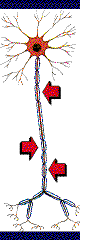Severe Diffuse Axonal Injury
Severe Diffuse Axonal Injury
Call me at 800-992-9447
Severe Diffuse Axonal Injury is one of the most dangerous pathological conditions that can occur. It is the cause of death in most cases where the patient never makes it to the hospital. Diffuse axonal injury is injury to the axons and axonal tracts, which criss-cross different layers of the brain. See our pages on Neuron and Axon starting here. In diffuse axonal injury, the axons are said to be sheared off the by the sliding of different layers across each other when the head is rapidly accelerated and decelerated in a traumatic event. Thus, diffuse axonal injury is also called a “shearing injury.”
Most discussions of diffuse axonal injury start from the perspective of concussion or mild traumatic brain injury. In its milder forms, diffuse axonal injury (DAI) is the pathological condition which explains permanent injury from milder brain trauma.
Thus, if something has the capacity to disable in its milder manifestations, it can be catastrophic when raised to the level of Severe Diffuse Axonal Injury. The primary difference between what happens in MTBI and Severe Diffuse Axonal Injury is that in the milder cases, the axon is stretched and becomes damaged over time, where in the severe cases, it is often torn immediately. The other difference is likely to be the number of the brain’s axonal tracts that are sheared.
DAI is graded Type One thru Type Three. Type One DAI is the most mild and Type Three, the most severe. Though Type Three DAI can result in immediate unconsciousness, it does not necessarily show up on either CT or MRI in the emergency stage. Severe Diffuse Axonal Injury, Type Three is the cause of severe brain injury which involve immediate coma, where the person was unconscious from the moment of the accident.
In the context of MTBI and concussion, I have made the analogy that the stretching of the axons in Type One DAI, is comparable to spraining an ankle. Severe Diffuse Axonal Injury, or Type Three DAI, is the equivalent to breaking the ankle. The axon is sheared off by the force.
For my more on the neuropathology of shear injuries, click here.




